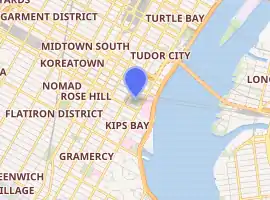Kips Bay Towers
Kips Bay Towers is a large two-building condominium complex in the Kips Bay neighborhood of Manhattan with a total of 1,118 units. The complex was designed by architects I.M. Pei and S. J. Kessler,[1] with the involvement of James Ingo Freed,[2] in the brutalist style[3][4] and completed in 1965.[1] The project was developed by Webb & Knapp.[5]
| Kips Bay Towers | |
|---|---|
 North Building (2010) | |

| |
| General information | |
| Status | Complete |
| Type | Residential |
| Location | 30th Street to 33rd Street between First Avenue and Second Avenue New York, NY, United States |
| Coordinates | 40°44′34″N 73°58′33″W |
| Opening | 1960 (south tower), 1965 (north tower)[1] |
| Technical details | |
| Floor count | 20 |
| Design and construction | |
| Architect | I.M. Pei, S. J. Kessler and James Ingo Freed |
The complex occupies an area of three city blocks, or approximately 7.5 acres (3.0 ha), bounded by First and Second avenues and East 30th and 33rd streets. The complex includes two residential high-rise buildings each with 20 floors. Additionally, there is a three-acre private garden between the two towers featuring landscaped lawns as well as recreational spaces. Kips Bay Towers is home to more than 4,000 residents.[6]
History
The project, originally known as Kips Bay Plaza, was conceived as a middle-income rental project, but was converted to condominium apartments in the mid-1980s, despite controversy with holdout tenants.[7]
The project was originally built as a slum clearance project under Title I of the federal Housing Act of 1949. In November 1981, a plan to convert Kips Bay Towers into condominiums became effective, however, the conversion was bogged down in litigation. By 1984, approximately 70% of the apartments had been purchased, 50% by existing tenants and the remaining 20% by non-residents.[8]
Kips Bay Towers was built on the site of the first Phipps Houses, at 321-337 East 31st Street, designed by Grosvenor Atterbury in 1906. The Phipps family had built three six-story tenements with 142 apartments between Second and Third avenues. Phipps allowed the 31st Street houses go in a condemnation proceeding, ultimately resulting in the construction of the Kips Bay Towers.[9]
Architect I. M. Pei had originally wanted a large sculpture by Picasso placed in the middle of the development's park. William Zeckendorf, the head of the development company, Webb & Knapp, told Pei that he could have either the sculpture or fifty saplings, and Pei chose the trees.[5]
In the mid-1990s, J. D. Carlisle Development Corporation constructed a retail facility along Second Avenue from 30th Street to 32nd Street connected to the Kips Bay Towers complex.[10] The retail construction was built on the site of "Kips Bay Gardens" a park and playground that was owned and operated by the Kips Bay Towers organization. Kips Bay Gardens was constructed at the time of the opening of the "Towers" in the early 1960s, and was open to the public till security concerns about the increasing homeless population prompted the privatizing of the park in 1983, leading to backlash from the surrounding community.[11]
References
- Notes
- White, Norval & Willensky, Elliot (2000). AIA Guide to New York City (4th ed.). New York: Three Rivers Press. ISBN 978-0-8129-3107-5., pp.218-219
- Dunlap, David W. (December 17, 2005). "James Ingo Freed, 75, Dies; Designed Holocaust Museum". The New York Times. Retrieved July 31, 2010.
- "Beautiful Brutes". The New York Times. April 24, 2010. Retrieved July 31, 2010.
- Muschamp, Herbert (November 17, 1996). "Considering the Once and Future Whitney Museum". The New York Times. Retrieved July 31, 2010.
- "Archived copy". Archived from the original on July 21, 2011. Retrieved May 5, 2011.CS1 maint: archived copy as title (link)
- Ramirez, Anthony (November 30, 1997). "The Hole That Swallowed the Swings". The New York Times. Retrieved July 31, 2010.
- Hinds, Michael Decourcy (October 26, 1986). "For New Yorkers, Is There Life After Rent Deregulation?". The New York Times. Retrieved July 31, 2010.
- Blair, William G. (May 10, 1984). "Condiminium Sales at Kips Bay Towers Are Upheld By Judge". The New York Times. Retrieved July 31, 2010.
- Gray, Christopher (November 23, 2003). "Henry Phipps and Phipps Houses; Millionaire's Effort to Improve Housing for the Poor". The New York Times. Retrieved July 31, 2010.
- Oser, Alan S. (June 16, 1999). "A Mixed-Use Tower for Theaters and Apartments". The New York Times. Retrieved July 31, 2010.
- Blair, William (November 9, 1983). "CLOSING OF KIPS BAY GARDEN DRAWS FIRE". The New York Times. The New York Times. Retrieved June 20, 2015.
- Bibliography
- Cohen, Joyce (April 11, 1999). "If You're Thinking of Living In/Kips Bay; Cohesive, With a Relaxed Ambiance". The New York Times. Retrieved July 31, 2010.
- Blair, William G. (November 9, 1983). "Closing of Kips Bay Garden Draws Fire". The New York Times. Retrieved July 31, 2010.
- Hinds, Michael Decourcy (July 29, 1984). "Kips Bay Prices Rise 40% After Moratorium". The New York Times. Retrieved July 31, 2010.
- Rozhon, Tracie (October 26, 2000). "The Condo Board That Stole Halloween". The New York Times. Retrieved July 31, 2010.
- "A Preservationist's List of 35 Modern Landmarks-in-Waiting". The New York Times. November 17, 1996. Retrieved July 31, 2010.
External links
| Wikimedia Commons has media related to Kips Bay Plaza. |